A science and exploration blog by Dr Adrian Glover, Dr Thomas Dahlgren and colleagues. 3682m is the average depth of the world's oceans. We are exploring the deep sea from the poles to the tropics. We have returned from the RRS James Clark Ross to explore the animals living under an Antarctic Ice Shelf. Our next expedition is in May-June 2018 to the deep tropical Pacific abyss, to the south of the island of Hawaii. RRS James Clark Ross PositionLarsen C Expedition TweetsNHM Oceans Larsen C Project Details
Don't wanna be here? Send us removal request.
Text
The Perfect Oceanographic Research Ship
[A post written on the last voyage, but did not send at the time owing to bandwidth. We are back home now and the next posts will be from our May-June voyage to the tropical Pacific abyss].
Attention, designers of oceanographic research ships!
Please find attached here some suggestions for your next ship. Based on experience that is biased towards sampling the biology of the seafloor, but from a reasonable sample size of 19 voyages on 12 different ships from 4 different nations.
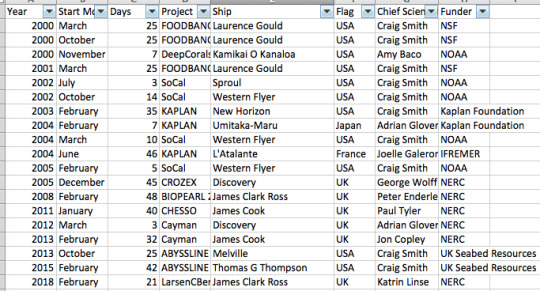
I have kept a tally of the various voyages I have been on.
So, your (wealthy) government has given the green light to a new ship to fly the flag of science and exploration (only subtly tinged with that of your nation state), 200m USD+ are in the bank, you have a nice little scale model and a good boaty name.
What to start with?
Lets start with the colour, and the general look of it. Clean lines, dark navy hull with some stripes I think. Going to France for style points, we could do a lot worse than the L’Atalante, an attractive ship I sailed on in 2004. Is there a reason polar ships need to be bright orange? I can’t think of one.

Your flagship should look a bit like this. L’Atalante in 2004, Manzanillo.

And not like this. The Laurence M Gould at Palmer Station, Antarctica. (But I have a soft spot for it as the first ship I sailed on).
Moving on, lets think about the deck and the working areas outside. We normally just call this the ‘back deck’ but most ships have a bit of deck on the starboard side where you can also lower equipment to the seafloor. The ship we are on now, James Clark Ross (JCR) has this just right. Wooden decking to soften the noise of equipment and plenty of space to tie everything down. Key thing to bear in mind is enough room to install the launch and recovery system, and control vans for a big Remotely Operated Vehicle (ROV) such as the UK’s Isis. You will need a ship that is about 100m long to fit all this stuff in. Smaller is not really an option.
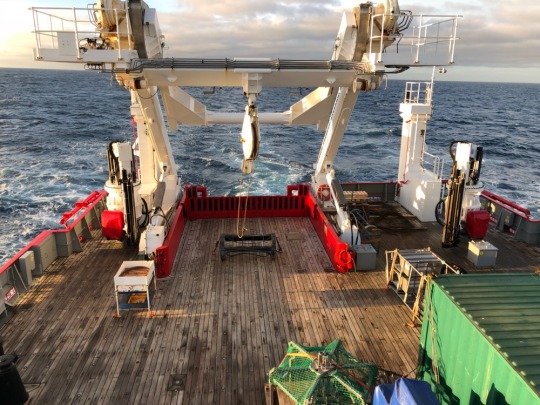
Lovely wooden decks on the James Clark Ross. Not for sipping G&Ts on.

You need to be able to fit one of these. The 6500m-rated ROV ‘Isis’.
One other key thing that almost every ship I have been on has forgotten to take care of: clean, filtered, chilled seawater system on the back deck. Every single seafloor biology expedition needs this, but its never there. We usually have to invent this with buckets, hoses, pumps, garden filters and running in and out of cold temperature storage rooms.
Deep-sea animals are used to temperatures of -2 to +2 °C, never more than that. Surface waters in most of the world’s oceans (where ships pull their seawater) is much higher, in the tropics as much as 28°C. Trying to photograph and keep alive deep-sea animals without cold filtered seawater is impossible. 

Back deck of the Thomas G Thompson. Cold 4°C filtered seawater sieving in 28°C surface waters in the tropical Pacific. Yes, the entire (essential) thing is something we built with old pallets and stuff from Home Depot on the back deck of a 150m dollar research ship.
All of this mucking around with hoses is the only way to get this:

A live syllid polychaete that we have just dissected out of a deep-sea sponge on this expedition. Image credit: A Glover & T Dahlgren.
In an environment as poorly-studied as the deep-sea, live observation of animals, either from ROV or down the microscope is essential to any understanding of deep-sea ecology.
Which brings us to the inside of our Perfect Oceanographic Research Ship (acronym needed). Moving from the back deck, we come into the ship’s research labs, the vital heart of the vessel’s science operations. There seems to be two routes that designers use here. Firstly there is the ‘Rabbit Warren’ approach where everything is split into multiple labs. JCR is an example of this: Main Lab, Bio Lab, Rad Lab, Chem Lab, Underway Instrument Control lab - to name a few. All separated by heavy doors and narrow passages. Most other ships are also like this.
I am not a fan of the multiple-labs approach. Firstly, doors on ships are a complete nightmare. They are heavy, swinging objects that cause frequent injury and are impossible to open when holding a tray of samples (or Tea). Secondly, you can never find anyone. I can see an argument that some activities need to be split off, for example radioisotope work. But in general its not necessary.
Instead, our Perfect ship has one giant lab that runs most of the length of the ship, on the same level as the back deck. Its centrally positioned and low-down to minimise movement (e.g for microscope work). Alongside it, on each side, are electric sliding doors (operated by push button with your elbow when carrying sample trays) that let you into certain special areas (e.g cold-temperature rooms, -80C freezer room, -20C walk-in freezer, tea/coffee, rest room etc).
The first part of our Perfect lab is the wet area, nearest the back deck. There is drainage, a giant sorting table for dealing with animals and samples, plenty of sinks, hoses with fresh and cold filtered seawater, room for aquaria and anything splashy or muddy basically. Right next to it (through a handy sliding door) is a nice big warm room to hang wet deck gear in to dry off. There is of course, a heated rack to put your soaking gloves and boots on (ski boot racks would work).
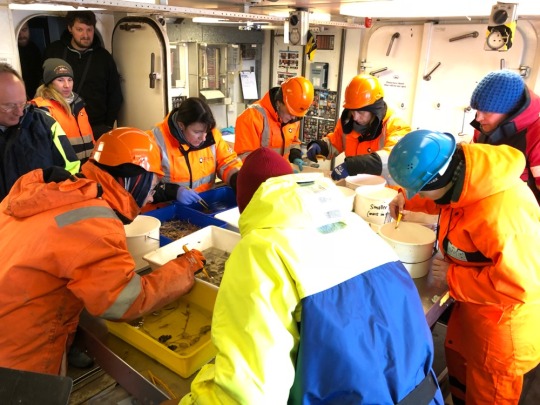
Imagine something about five times as big as this wet lab. With good lighting so you can see what you are doing.
Some basic partitions and floor raises separate this wet area from the next part of our Perfect lab. This will be a general use lab with big long stand-up lab benches, plenty of shelving, racks and places to stow things. Its adaptable to almost any normal lab activity, whether microscope work, sample processing and so on. For dealing with nasty chemicals, a specialist room on one side is available with fume hoods and everything required. This is also where the walk-in freezers and cold-temperature rooms are located.

Maddie Brasier demonstrating perfectly normal lab activities in a not-perfect lab on a ship.
Going forward from this area, some partitions (but not doors) separate this main lab from the next section - the instrument control area. Here we have a giant chart table in the middle of the room, with a large flat display hanging next to it for bringing up images and data. A plotter is there that can bring A0 maps straight from the ships mapping/bathymetry systems onto the chart table. Along each side of this room section is instrument racks with all the onboard data systems (standard stuff like navigation, seafloor bathymetry, data from the standard oceanography instruments such as CTD, all the winch data, comms to the winch control and acoustic systems). There is plenty of space to stand around the giant chart table, look at the screens and discuss science and the plan. Aiding this process is definitely a coffee machine and probably a coke dispenser.
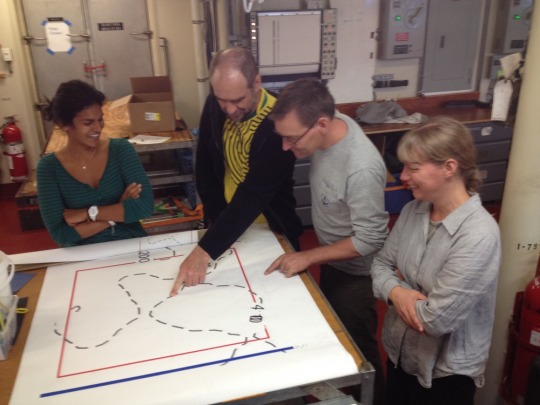
Craig Smith, Diva Amon, Thomas Dahlgren and Helena Wiklund demonstrating the importance of a chart table (home built, of course). In this case showing that we have no information whatsoever on the place we are going in the abyssal Pacific.
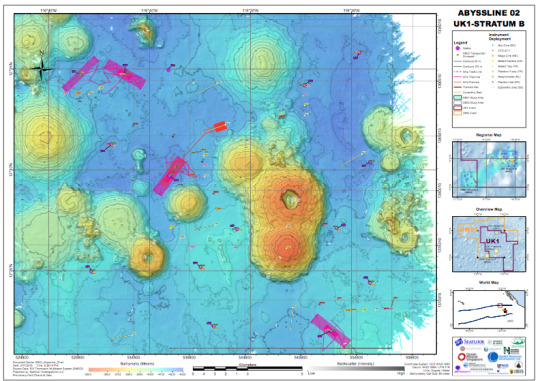
But later on we did. Image credit Craig R Smith.
Beyond this instrument control area, a large and comfortable area is set aside as an open-plan office, but perhaps adaptable so can be used as extra lab space if needed. Plenty of nice seating, laptop plug-in points and so on. Its vital on a multi-disciplinary oceanographic cruise that everyone talks to each other and works together. This room could be nicely finished with a couple of large sofas, and another large screen which could be used to mirror ROV data, or watch movies in downtime.
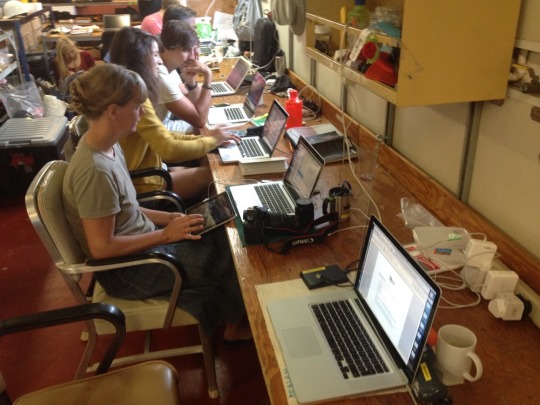
Laptop space is a premium on the RV Melville. Yes, there is one person sitting on the floor.
So our Perfect Oceanographic Research Ship has a main deck in which almost all the science takes place. We will also need a large conference room from time to time, but these are not used that much and it can be tucked away on a higher level in the ship. Below this deck will be all the ship’s engineering (which I wont go into, but suffice to say its the latest technology and with a bit more power than you think you might need, for example to break sea ice).
Above is the living quarters for the scientists and crew and above that the bridge and associated rooms such as comms systems, radio rooms, offices for the master and ship’s officers etc. Needless to say, our Perfect ship will have high-bandwidth internet throughout. Its more essential than ever to broadcast live our results, engage the public in our science and have the ability to access internet to make decisions on the fly.
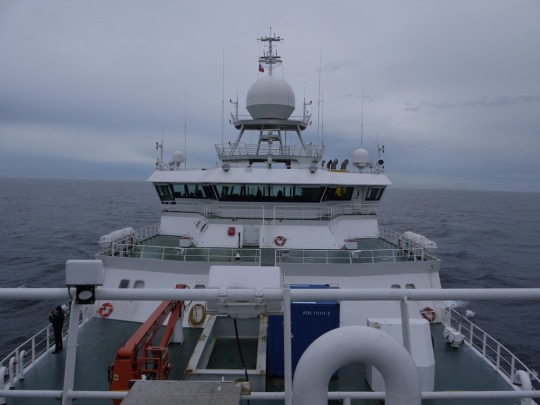
The big internet dome on top of the RRS James Cook. Inside is just a normal satellite dish on a gimble that rotates so it points towards the satellite all the time.
And so to the living quarters. This is pretty important - we can be at sea for up to 50 days, with about 50 people on the ship (typically, half scientists/technicians and half officers and crew). I think at this point, it could be said that modelling the entire thing on the James Clark Ross would be a good start. Its the most comfortable ship I have been on. The living areas are quiet, carpeted and cosy. Pictures from past expeditions hang on the wall. There is a lovely bar and saloon where we can get beers at the end of our shift, and tea/coffee at any time. Dining is in a saloon with white tablecloths, personal napkin rings (so we re-use a real linen napkin each day, they get washed once a week) and not a single piece of disposable cloth or plastic in sight. JCR was years ahead of the anti-plastic environmental lobby.
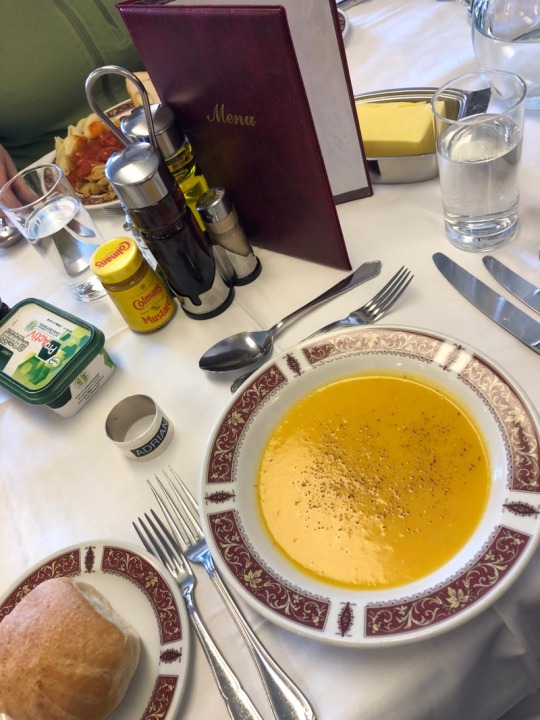
Dinner on the RRS James Clark Ross. Yes, there is a soup spoon.
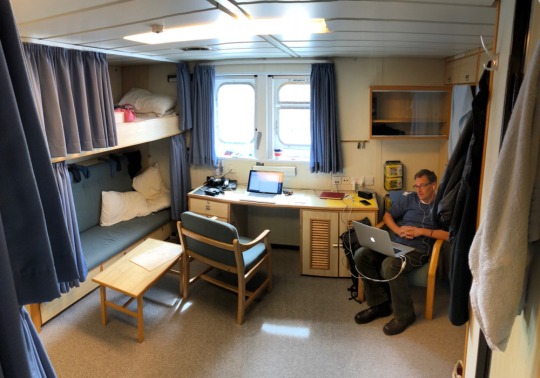
A comfy cabin on the James Clark Ross. Thomas is being interviewed via skype audio with a Swedish radio station interested in our voyage.
There is a nice selection of single, twin or 4-berth cabins which gives the chief scientist quite a bit of flexibility in berthing. On this occasion, I share a cabin with Thomas, but its a 4-berth cabin just for us so we have plenty of space, our own bathroom/shower and even a sofa and a fridge to store the beers in.
I could not think how to improve it much, perhaps the only thing we miss from many years on US boats is a movie room with giant sofas. But then the US boats dont come with a bar.
Finally, and most importantly, our Perfect ship needs an underwater viewing dome. On the RV Melville, I had heard about this but thought it was a crew joke. But no, they took us down to the very bottom of the ship, and into a little pod that poked out of the bow, switched off the lights and opened the portholes to that great mystery of our planet - the pelagic seas - alive with bioluminescence.
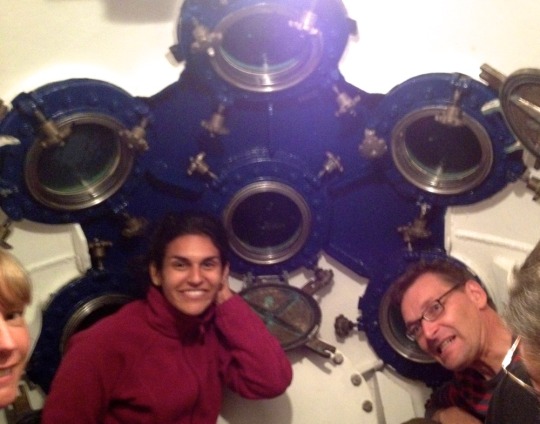
The underwater viewing dome on the now-retired RV Melville. It really exists! All that it needs is a beer fridge and a sofa.
Post and images by Dr Adrian Glover Ship’s position: https://goo.gl/pcLA6f NHM / Uni Gothenburg Micro-blog: http://3682m.tumblr.com #LarsenCBenthos Tweets: https://goo.gl/Bs82cS
0 notes
Photo

Last view of Antarctica. Bransfield Island.
Post and images by Dr Adrian Glover
Ship’s position: https://goo.gl/pcLA6f NHM / Uni Gothenburg Micro-blog: http://3682m.tumblr.com #LarsenCBenthos Tweets: https://goo.gl/Bs82cS
0 notes
Photo

Post and images by Dr Adrian Glover
Ship’s position: https://goo.gl/pcLA6f NHM / Uni Gothenburg Micro-blog: http://3682m.tumblr.com #LarsenCBenthos Tweets: https://goo.gl/Bs82cS
0 notes
Video
tumblr
We are on our way out now, so last few shots. Realised I have not posted any penguin video. Did not get particularly close so experimented with shooting in 4K on max zoom and cropping a bit.
Adelie penguins near James Ross Island in the pack.
Post and images by Dr Adrian Glover
Ship’s position: https://goo.gl/pcLA6f NHM / Uni Gothenburg Micro-blog: http://3682m.tumblr.com #LarsenCBenthos Tweets: https://goo.gl/Bs82cS
0 notes
Text
A lovely day in the Antarctic summer doing marine biology
We are now sampling intensively the Prince Gustav Channel in Antarctica. How are we doing this? What have we found? Some highlights here from the last 24 hours.

We sample the seafloor with many types of equipment. This is one of the best - an epibenthic sledge with a camera attached. It skims along the seabed and grabs small samples of fauna living on the mud. Heroic efforts here from Carwyn and Bjoerg from the BAS AME team bringing the sample onto deck. Its as cold as it looks. Antarctica above the sea surface is basically bloody horrible most of the time.

Data to prove how nasty it is here in ‘summer’. -13.4C and 24knots wind is over -40C wind chill. The seawater freezes instantly on touching the deck.

Slightly more old-fashioned sampling method - a small Agassiz Trawl.

Sorting the trawl catch, Antarctica, 2018.

Sorting the trawl catch, Antarctica, 1912. This is Dennis Lillie and Murray Levick, marine biologists on Robert Scott’s British Antarctic Expedition 1910-1913. Image source: https://goo.gl/KWg5Fp

Sometimes we take small sediment cores, which can bring back perfectly undisturbed sediment from the seafloor.

As realised here - the surface of the seafloor from 1200m down in the deep Prince Gustav channel. You can see a terebellid polychaete tube in the foreground. All the fauna is alive and well in the cold temperatures.

Time for some beasties. These are images taken down a microscope of the animals in the mud. Cirratulid polychaete with eggs. About 3mm.

We are getting lots of these burrowing ophelliid polychaetes. About 2mm long.

A dorvilleid polychaete.

A hesionid polychaete.

A maldanid polychaete. Also known as a ‘bamboo worm’.

Sampling continues. Thomas is contemplating our next expedition in the tropical Pacific.
Images all by Adrian Glover and Thomas Dahlgren. Please contact us for permission to re-use.
Ship’s position: https://goo.gl/pcLA6f NHM / Uni Gothenburg Micro-blog: http://3682m.tumblr.com #LarsenCBenthos Tweets: https://goo.gl/Bs82cS
2 notes
·
View notes
Video
tumblr
We just found a nice route through some pack ice at the southern end of Prince Gustav channel.
This will take us down to an area formerly covered by an ice shelf in 1995.
The coast was first mapped by the explorer Otto Nordenskjöld in the Swedish South Polar Expedition 1901-1904. Ahead of the ship is Cape Obelisk, noted for a dramatic pinnacle that is set just slightly inland.
Nordenskjöld named the island for the explorer James Clark Ross, who was the last person to visit it before him, in 1843, on his last expedition to the Southern Ocean.
Both Ross and Nordenskjöld made observations of a floating ice shelf that lay across the Prince Gustav Channel and extended around the southern part of what is now James Ross Island. These observations are analysed in a fascinating paper by A.P.R. Cooper (1997) who made an estimate of the extent of the shelf based on these historical data.
This was the same ice shelf that completely broke up in 1995 at the same time as the dramatic break up of the entire Larsen A ice shelf.
So we are now sampling the seafloor in an area where there was an ice shelf 23 years ago, in a ship named for the explorer James Clark Ross, next to James Ross Island, in a channel named for a Swedish Prince by the explorer Otto Nordenskjöld.
In Antarctica there are a lot of connections.
Reference:
Cooper, A. P. R. "Historical observations of Prince Gustav ice shelf." Polar Record 33.187 (1997): 285-294.
Thanks to Thomas Dahlgren for finding this reference and all the information on Otto Nordenskjöld. (He is only a bit obsessed....)
Post and images by Dr Adrian Glover
Ship’s position: https://goo.gl/pcLA6f NHM / Uni Gothenburg Micro-blog: http://3682m.tumblr.com #LarsenCBenthos Tweets: https://goo.gl/Bs82cS
0 notes
Quote
If it was easy, everybody would be doing it
Prof Monty Priede, Emeritus Professor, University of Aberdeen
We have had a tough few days on the #LarsenCBenthos expedition. Firstly we could not get to the ice shelf as planned. Thick, multi-year pack ice prevented us getting there despite enormous efforts from the ship’s officers and crew.
It will be interesting to see if the Korean icebreaker Araon makes it on a planned visit in mid April. They have quite a bit more engine power (10MW as opposed to at most 8MW on James Clark Ross) but this is still far lower than what would be classed as a full “polar-class” icebreaker such as the veteran US cutter Polar Star which has well over 50MW of power. We wish them good luck! If the winds are favourable, the pack might blow out and create a route in.
We have re-grouped and focussed our new efforts on studying the Prince Gustav channel around James Ross Island, and are trying to get in to areas formerly covered by an ice shelf in 1995.
Its a spectacular place.

Sea ice forming around the ship this morning, with James Ross Island in the background and a spot called Gin Cove.

We took some good benthic samples - here a multi-core of seafloor sediment.

A 6cm scale-worm (Polynoidae) from the seafloor at 1000m depth.

A terebellid worm tube (the hole with tentacles) visible in this seafloor image. These are deposit feeders that spread their tentacles over the muddy surface to pull down food particles into their stomachs.

We have had some problems with our main trawl winch, and have been taking deep-water samples.

That @mucofloris and I have been filtering on a very fine filter to collect environmental DNA samples. Will we be able to detect seafloor large animal species by collecting DNA from the water column above? We will find out!

Its about -10C on the deck at the moment. But very pretty. Work carries on.
Post and images by Dr Adrian Glover
Ship’s position: https://goo.gl/pcLA6f NHM / Uni Gothenburg Micro-blog: http://3682m.tumblr.com #LarsenCBenthos Tweets: https://goo.gl/Bs82cS
1 note
·
View note
Photo


Sightly better snow petrel image. They move fast.

Iceberg of the day. With creepy cave!

Self-portrait.

Snoozing Weddell seal.

And awake.
Hope to start benthic sampling tomorrow...
Post and images by Dr Adrian Glover
Ship’s position: https://goo.gl/pcLA6f NHM / Uni Gothenburg Micro-blog: http://3682m.tumblr.com #LarsenCBenthos Tweets: https://goo.gl/Bs82cS
0 notes
Quote
I have been thinking much of our prospects
Ernest Shackleton, South (1920).


Iceberg of the day.

Snow petrel, with context.
Post by Dr Adrian Glover
Ship’s position: https://goo.gl/pcLA6f NHM / Uni Gothenburg Micro-blog: http://3682m.tumblr.com #LarsenCBenthos Tweets: https://goo.gl/Bs82cS
0 notes
Video
tumblr
Navigating the leads South on RRS James Clark Ross.
Post by Dr Adrian Glover
Ship’s position: https://goo.gl/pcLA6f NHM / Uni Gothenburg Micro-blog: http://3682m.tumblr.com #LarsenCBenthos Tweets: https://goo.gl/Bs82cS
0 notes
Text
Weddell Sea, About Tea-Time

Iceberg of the day.

Icey McIceFace.



Enough already!
Images and Post by Dr Adrian Glover
Ship’s position: https://goo.gl/pcLA6f NHM / Uni Gothenburg Micro-blog: http://3682m.tumblr.com #LarsenCBenthos Tweets: https://goo.gl/Bs82cS
0 notes
Photo

Hello, crabeater seal.
Post by Dr Adrian Glover
Ship’s position: https://goo.gl/pcLA6f NHM / Uni Gothenburg Micro-blog: http://3682m.tumblr.com #LarsenCBenthos Tweets: https://goo.gl/Bs82cS
0 notes
Video
tumblr

Into the night.
Post by Dr Adrian Glover
Ship’s position: https://goo.gl/pcLA6f NHM / Uni Gothenburg Micro-blog: http://3682m.tumblr.com #LarsenCBenthos Tweets: https://goo.gl/Bs82cS
1 note
·
View note
Quote
Thick fogs, Snow storms, Intense Cold and every other thing that can render Navigation dangerous one has to encounter and these difficulties are greatly heightened by the enexpressable horrid aspect of the Country, a Country doomed by Nature never once to feel the warmth of the Suns rays, but to lie for ever buried under everlasting snow and ice.
Captain James Cook, 1773, Second Voyage aboard HMS Resolution and Adventure. Quote from Rubin (2000) Antarctica. Cook reached 71S but did not sight land.


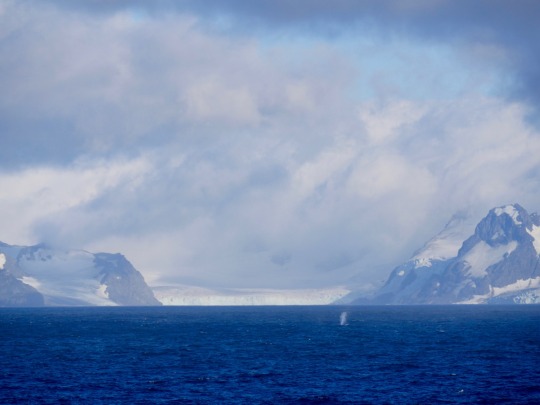
But the sun did come out for us, and a large group of large baleen whales.
Passing Elephant Island.
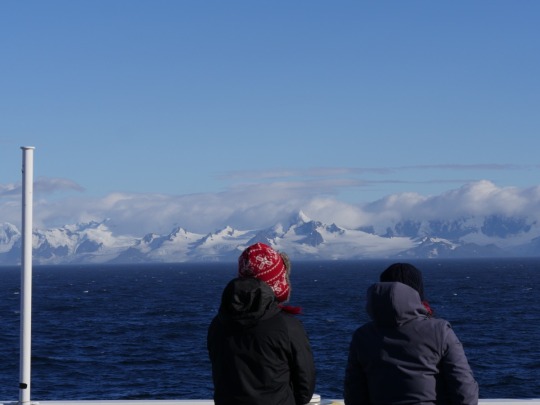
Post by Dr Adrian Glover
Ship’s position: https://goo.gl/pcLA6f NHM / Uni Gothenburg Micro-blog: http://3682m.tumblr.com #LarsenCBenthos Tweets: https://goo.gl/Bs82cS
1 note
·
View note
Quote
a prospect the most gloomy that can be imagined... the only cheer the sight afforded was in the idea that this might be the long-sought Southern Continent
Charles Poynter, Midshipman to Edward Bransfield, sighting Antarctica for the first time in January 1820. From Rubin (2000) Antarctica, probably from https://goo.gl/8sfp4a
We plunge South in RRS James Clark Ross, in thick fog and grey Southern Ocean rollers. Our first sighting of Antarctic land should be Elephant Island tomorrow morning about 8am.
Post by Dr Adrian Glover
Ship’s position: https://goo.gl/pcLA6f NHM / Uni Gothenburg Micro-blog: http://3682m.tumblr.com #LarsenCBenthos Tweets: https://goo.gl/Bs82cS
0 notes
Photo

The basic idea for photographing wheeling albatrosses is you go up to the top deck and spin around like a mad person snapping wildly with your camera.
Black-browed albatross and some ship structure.
Images and post by Dr Adrian Glover
Ship’s position: https://goo.gl/pcLA6f NHM / Uni Gothenburg Micro-blog: http://3682m.tumblr.com #LarsenCBenthos Tweets: https://goo.gl/Bs82cS
0 notes
Photo

Grey petrel, sunset.
Images and post by Dr Adrian Glover
Ship’s position: https://goo.gl/pcLA6f NHM / Uni Gothenburg Micro-blog: http://3682m.tumblr.com #LarsenCBenthos Tweets: https://goo.gl/Bs82cS
0 notes